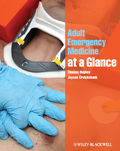
Following the familiar, easy-to-use at a Glance format, and in full-colour, this brand new title provides an accessible introduction and revision aid for medical students and junior doctors. Reflecting the increased profile of Emergency Medicine in clinical practice and the medical school curriculum, Adult Emergency Medicine at a Glance provides a user-friendly overview of the key subjects that will enable any student or junior doctor to hit the ground running when they enter one of the most exciting areas of clinical medicine. Adult Emergency Medicine at a Glance is: A concise, visually orientated course in emergency medicine that is perfect for both study and revision Organised around symptoms: Short of Breath, rather than diagnoses: Pneumonia Focused on the most common or dangerous conditions you will see in the Emergency Department and includes the latest cardiac resuscitation guidelines Comprehensively illustrated throughout with over 47 full-page colour illustrations INDICE: Preface and acknowledgements. List of abbreviations. 1 Life in theEmergency Department. 2 Diagnosis. 3 Shock and intravenous fluids. 4 Imaging in the Emergency Department. 5 Analgesia. 6 Airway management and sedation. 7 Blood gas analysis. 8 Trauma: primary survey. 9 Trauma: secondary survey. 10 Major head and neck injury. 11 Minor head and neck injury. 12 Wounds. 13 Burns.14 Hand injuries. 15 Wrist and forearm injuries. 16 Shoulder and elbow injuries. 17 Back pain, hip and knee injuries. 18 Tibia, ankle and foot injuries. 19Abdominal pain. 20 Urology problems. 21 Ear, nose, throat and dental problems. 22 Eye problems. 23 Obstetrics and gynaecology problems. 24 Toxicology: general principles. 25 Toxicology: specifi c poisons. 26 Psychiatry: self-harm andcapacity. 27 Psychiatry: the disturbed patient. 28 Observational medicine. 29Loss of function and independence. 30 Syncope, collapse and falls. 31 Slow heart rate. 32 Fast heart rate. 33 Cardiac arrest. 34 Chest pain: cardiovascular. 35 Chest pain: non-cardiovascular. 36 Shortness of breath. 37 Anaphylaxis. 38 Sepsis. 39 Endocrine emergencies. 40 Gastroenterology. 41 Headache. 42 Stroke and transient ischaemic attack. 43 Seizures. 44 Hypothermia and hyperthermia. 45 Pre-hospital medicine. 46 Major incident. 47 Chemical, biological, radiation, nuclear and explosive incidents. Case studies: questions. Case studies: answers. Index.
- ISBN: 978-1-4051-8901-9
- Editorial: Wiley-Blackwell
- Encuadernacion: Rústica
- Páginas: 120
- Fecha Publicación: 25/02/2011
- Nº Volúmenes: 1
- Idioma: Inglés
